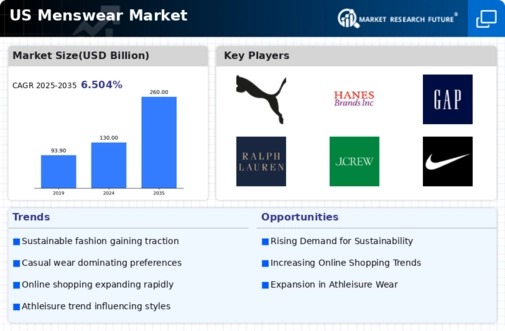The competitive landscape of the US Menswear Market is characterized by a diverse array of brands vying for consumer attention amid evolving fashion trends and changing consumer preferences. This market is influenced by a blend of established names and emerging labels that offer a wide range of products including casual wear, formal attire, sportswear, and athleisure options. As the industry adapts to seasonal trends and economic fluctuations, understanding the competitive dynamics becomes crucial for stakeholders seeking to carve out their niche.
The insights gleaned from this market reveal an environment shaped by brand loyalty, innovative marketing strategies, and an increasing demand for sustainability and ethical production practices. The rise of e-commerce has also transformed the purchasing landscape, prompting brands to enhance their online presence and customer engagement.Levi Strauss and Co has established itself as a dominant force in the US Menswear Market, benefiting from a rich heritage and a strong brand identity centered around denim products. Known for its iconic jeans, Levi's has developed a loyal customer base that appreciates both the quality and style of its offerings.
The company's commitment to innovation is reflected in its ongoing product development and ability to introduce new styles and fits that appeal to contemporary consumers. Levi Strauss and Co's robust distribution network includes both physical retail locations and a significant online presence, which has allowed the brand to effectively reach a wide audience.
The strength of the brand lies in its classic image, the versatility of its products, and its ability to leverage collaborations and licensing agreements that enhance brand visibility and market penetration.Puma plays a significant role in the US Menswear Market, focusing on sportswear and athleisure segments, appealing to consumers who prioritize both performance and fashion. The company's key products include athletic footwear, apparel, and accessories that cater to various lifestyle needs, from casual wear to rigorous athletic activities. Puma's strategic partnerships with athletes and celebrities have greatly enhanced its brand image and expanded its market presence.
The company has also embraced trends in sustainability, incorporating eco-friendly materials into its product lines, which resonates with environmentally conscious consumers. Mergers and acquisitions have bolstered Puma's competitive standing, allowing for enhanced resources and distribution capabilities. The brand's commitment to innovation, style, and performance positions it as a formidable player in the competitive landscape of the US Menswear Market, catering to a diverse consumer base seeking contemporary sportswear solutions.























Leave a Comment